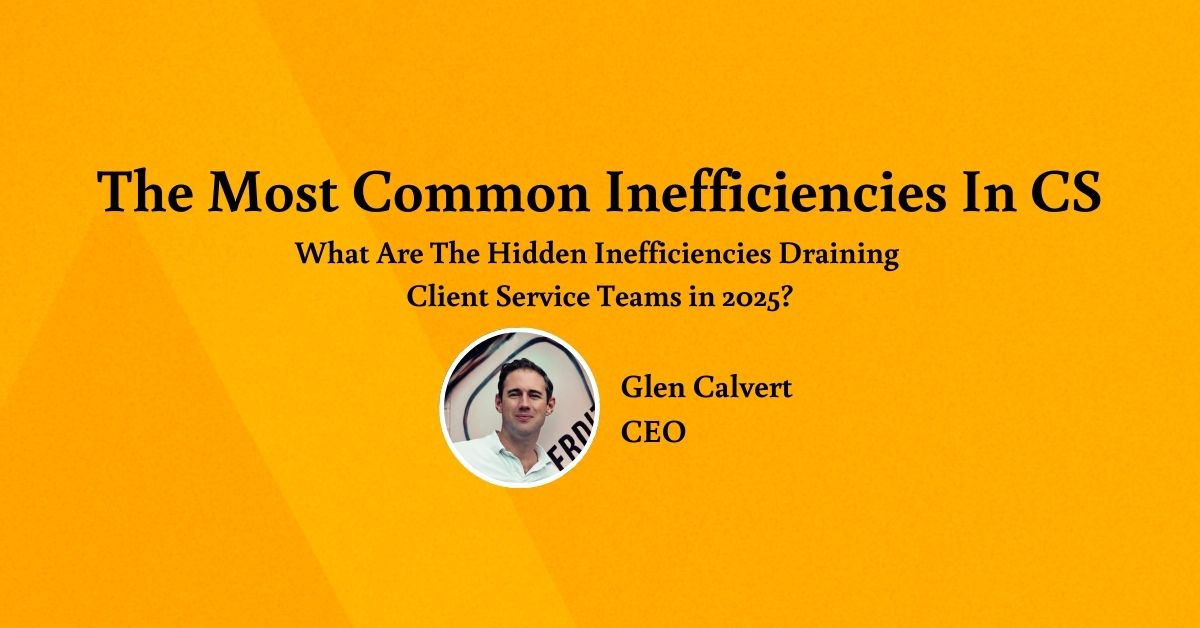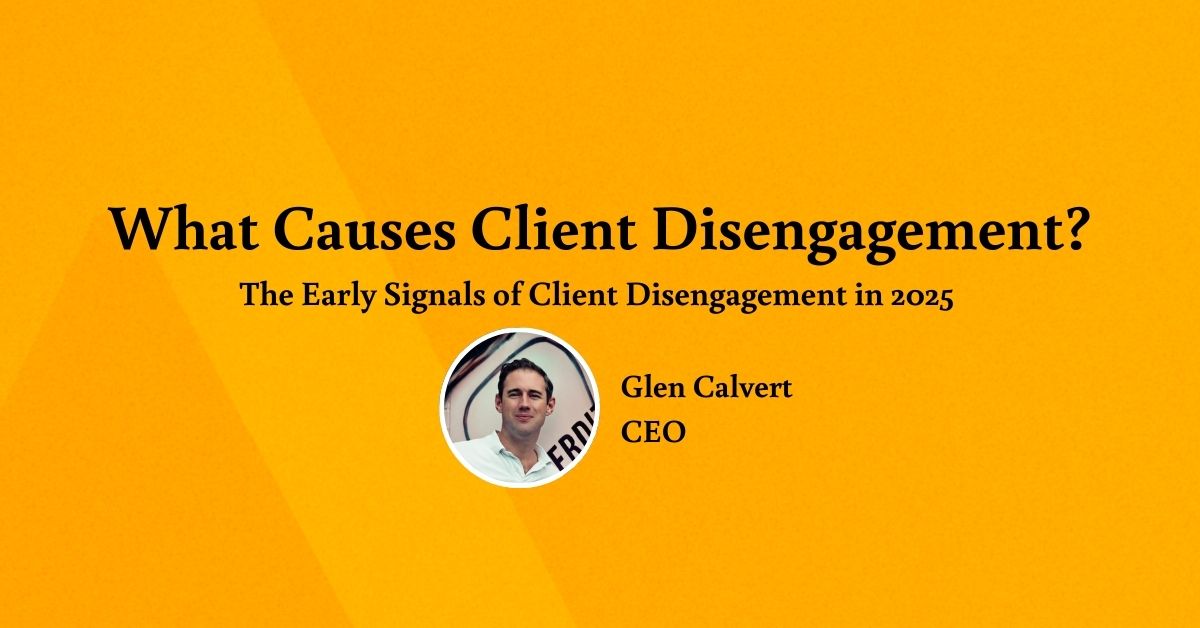Agentic Account Management: The New Era of Client Service

Agentic Account Management: The New Era of Client Service
AI Agents are about to enable a monumental shift in client management. At Kaizan, we have the privilege of working with progressive Client Service teams who are already leveraging AI; we get to see and hear what the future looks like based on their requests.
We’re beyond excited for what will be possible with Agentic Account Management.
Here’s what we’re seeing and some practical examples of how you can approach this generational opportunity…
The Current State: Time Pour & Reactive Client Service
The best Account Managers are drowning in admin. They spend their mornings chasing updates, their afternoons in reactive firefighting, and their evenings writing follow-up emails that should have been sent hours ago.
This isn’t sustainable.
More importantly, it’s not where their value lies or what clients pay them to do.
The future of Client Service in any managed or professional service environment isn’t about doing more of the same faster. It’s about fundamentally changing what Account Managers spend their time on and the tooling they use to do it.
AI Agents make that shift possible.
Walk into any team managing client relationships, any agency, tech enabled service, or consultancy and you’ll find the same pattern. The most skilled relationship managers are buried under operational tasks that could be automated.
Take Sarah, a senior Account Director at a mid-sized marketing agency. Her Tuesday started with forty minutes transcribing notes from yesterday’s client call to share with others. She then spent an hour hunting through email threads to find the latest project timeline and respond to requests. By lunch, she’d written three status updates and fielded six “quick questions” from junior team members who couldn’t find information that should have been at their fingertips.
The strategic work; spotting opportunities, anticipating client needs, building deeper relationships, and understanding the opportunities in the market gets pushed to the margins.
This isn’t just inefficient. It’s actively harmful to client relationships.
When Account Managers are reactive rather than proactive, they miss the subtle shifts in client sentiment that signal trouble ahead. They’re too busy managing information to properly manage relationships.
This is where Agentic Account Management comes in.
What AI Agents Actually Do
AI agents aren’t chatbots with exceptional GenAI capabilities . They’re autonomous systems that can interpret context, make decisions, and take action without constant human supervision.
In Client Service, for example, this means agents that can:
> Monitor all client communications and flag sentiment changes before they become issues
> Automatically compile stakeholder maps from all interactions (meetings and email exchanges) plus find additional stakeholders from org charts
> Draft and share meeting summaries and follow-up actions within minutes of a call ending
> Track competitive intelligence and surface relevant insights that match a client’s objectives
> Generate weekly account health reports autonomously without manual data gathering
The key difference from traditional automation is adaptability, as these systems learn from each interaction and improve their decision-making over time.
Three Specific Ways Agents Will Change Client Service
1. From Reactive to Proactive
Currently, most account teams only spot problems when clients explicitly raise them. By then, it’s often too late for elegant solutions.
Agentic account management will change this, as AI agents continuously monitor communication patterns, project timelines, and stakeholder engagement. They’ll flag when a previously engaged client contact starts taking longer to respond to emails, or when they notice budget approval processes are taking longer than usual. They’ll also identify when technical discussions are becoming more frequent – often a sign of underlying performance concerns, or notice market trends with the clients’ competitors that could impact your relationship.
This shifts the entire dynamic from crisis management to prevention. Account managers will receive alerts about potential issues weeks before they would have noticed them manually.
The changes to expect with Agentic Account Management:
> Automated sentiment analysis of all client communications with weekly trend reports
> Mapping best performing clients to those that decrease or churn and surfacing the differences and benchmarks between the two
> Real-time alerts when stakeholder engagement patterns shift
> Predictive scoring of account health based on communication frequency and tone
> Early warning systems for budget constraint signals in client conversations, service performance and market movements
2. From Information Hunting to Strategic Thinking
The average account manager spends 3-4 hours per week searching for information that already exists somewhere in their organisation. Meeting notes, project updates, stakeholder feedback, competitive intelligence – it’s all there, but scattered across different systems and team members’ heads.
AI agents will serve as institutional memory, automatically capturing, and organising this information. When preparing for a client meeting, instead of spending an hour hunting through old emails, account managers will have instant access to relevant context, recent developments, and strategic recommendations.
But the real transformation comes from market intelligence integration. AI agents will continuously monitor supplier landscapes, vendor performance data, and industry trends relevant to each client’s objectives. When a client mentions exploring new MarTech solutions, the agent will instantly surface vendor comparisons, pricing intelligence, and implementation timelines. When market conditions shift, agents will proactively suggest how these changes impact client strategies and recommend preemptive conversations.
This intelligence extends to supplier relationship management. Agents will track vendor performance across all clients, identifying which suppliers consistently deliver and which create friction. They’ll flag when vendor contract renewals are approaching and suggest optimisation opportunities based on performance data from similar client implementations.
These time savings aren’t just about efficiency. It’s about mental bandwidth. When you’re not mentally tracking dozens of operational details, you have more capacity for strategic thinking.
The changes to expect with Agentic Account Management:
> Instant access to complete client history and context for any meeting
> Automated competitive intelligence briefings before client calls
> Real-time vendor performance tracking and recommendation systems mapped to client needs and objectives
> Proactive market trend alerts tied to specific client objectives
> Automated supplier relationship mapping and optimisation recommendations
3. From Generic Service to Personalised Relationship Management
The best client relationships are deeply personal. They’re built on understanding individual stakeholders’ priorities, communication styles, and decision-making patterns, as well as the client’s business inside out.
AI agents will make this kind of personalisation scalable.
They’ll track how different stakeholders prefer to receive information, what topics they care most about, and how they typically respond to different types of proposals. This intelligence will inform everything from meeting agendas to communication timing.
What makes this truly powerful is the coaching dimension. AI agents will continuously analyse successful client interactions across your entire organisation, identifying patterns in what great client service actually looks like. They’ll flag when an account manager’s communication style isn’t resonating with a particular stakeholder and suggest adjustments. They’ll recommend optimal timing for difficult conversations based on historical data and stakeholder preferences.
This automated coaching extends to strategic guidance. Agents will analyse successful client outcomes and suggest replicable approaches for similar situations. When a client expresses frustration, the agent will immediately surface examples of how similar challenges were successfully resolved elsewhere, complete with recommended language and approach.
For account managers handling multiple relationships, this means being able to provide the kind of tailored service that was previously only possible with their most important clients.
The changes to expect with Agentic Account Management:
> Personalised stakeholder profiles with communication preferences and decision-making patterns
> Real-time coaching suggestions during client interactions trained on your companies corpus of client comms
> Automated identification of cross-sell and upsell opportunities based on similar client journeys and real-time client needs, either directly or indirectly expressed
> Customised meeting preparation with stakeholder-specific talking points
> Continuous feedback on communication effectiveness with improvement recommendations
The Implementation Reality
This transformation won’t happen overnight.
The most successful implementations will be gradual, starting with specific use cases rather than attempting to overhaul entire workflows at once.
The technical foundation requires building an “agent orchestration layer” – middleware that connects your existing tech stack and provides AI agents with unified data access. This typically involves API integrations between your CRM (Salesforce, HubSpot), communication platforms (Slack, Teams), project management tools (Monday, Asana), and all your other systems. The orchestration layer normalises data formats and provides agents with real-time access to client context.
Modern agent platforms use Large Language Models (LLMs) combined with retrieval-augmented generation (RAG) to query your integrated data sources. The agents are configured with specific “tools” or functions they can call like: searching CRM records, accessing meeting transcripts, pulling project timelines, or querying market intelligence APIs. These tools are defined through JSON schemas that specify exactly what data the agent can access and what actions it can perform, considering the users organisation permissions.
The most advanced implementations allow agents to perform semantic search across your entire client history and what the clients objectives are, finding relevant context even when exact keywords don’t match. Combined with fine-tuned models trained on your specific client service patterns, this creates agents that understand your business context at a granular level.
Agent workflows are typically configured through visual workflow builders that define triggers, decision trees, and action sequences. For example, an agent might be triggered when stakeholder sentiment drops below a threshold, which then automatically pulls relevant client history, drafts communication options, and alerts the account team with the recommended next steps.
The early adopters we’re seeing are starting with meeting intelligence; using AI to automatically generate summaries and action items from client calls. This provides immediate value while establishing the data foundation for more sophisticated applications to come.
The next wave typically involves sentiment and client satisfaction tracking and communication automation. Teams will soon be using agents to maintain comprehensive stakeholder databases and draft routine communications like project updates, outreach when engagement is low, and proactive market intelligence updates.
The most advanced implementations integrate competitive intelligence and predictive analytics, where AI agents proactively surface market insights and forecast account health based on communication patterns and engagement metrics, all to match what the client needs you to deliver for them.
What This Means for Account Management Teams
For individual Account Managers, this shift represents a fundamental change in job focus.
Less time on administrative tasks means more time for strategic client work. The most successful will be those who embrace this change and develop their strategic thinking and relationship-building skills.
For team leaders, the challenge is change management. The transition requires new workflows, different performance metrics, and often a cultural shift from reactive to proactive service delivery. It’s critical to explain to teams their job isn’t at risk and they’re not being monitored, AI tools are here to 10x their capabilities.
For organisations, this represents a competitive advantage that compounds over time and teams that implement AI agents effectively will deliver superior client service – faster – while operating more efficiently. Those that don’t will find themselves at an increasing disadvantage.
The Immediate Next Steps
The question isn’t whether AI agents will transform client service: rather, it’s how quickly your organisation can adapt to this new reality?
Start with pilot programmes in specific areas where the value is most obvious. Meeting intelligence and communication automation are typically the easiest wins. Build confidence and experience with these applications before expanding to more complex use cases.
Invest in training your team to work alongside AI agents. This isn’t about replacing human skills – it’s about augmenting them. The most successful account managers will be those who learn to direct and leverage AI capabilities effectively.
The future of Client Service and enterprise account management is proactive, intelligent, and deeply personalised: the future is Agentic Account Management. AI agents will be under your command to achieve client goals and give you new capabilities.
The only question is how quickly you’ll make the transition.
Glen Calvert, CEO of Kaizan



